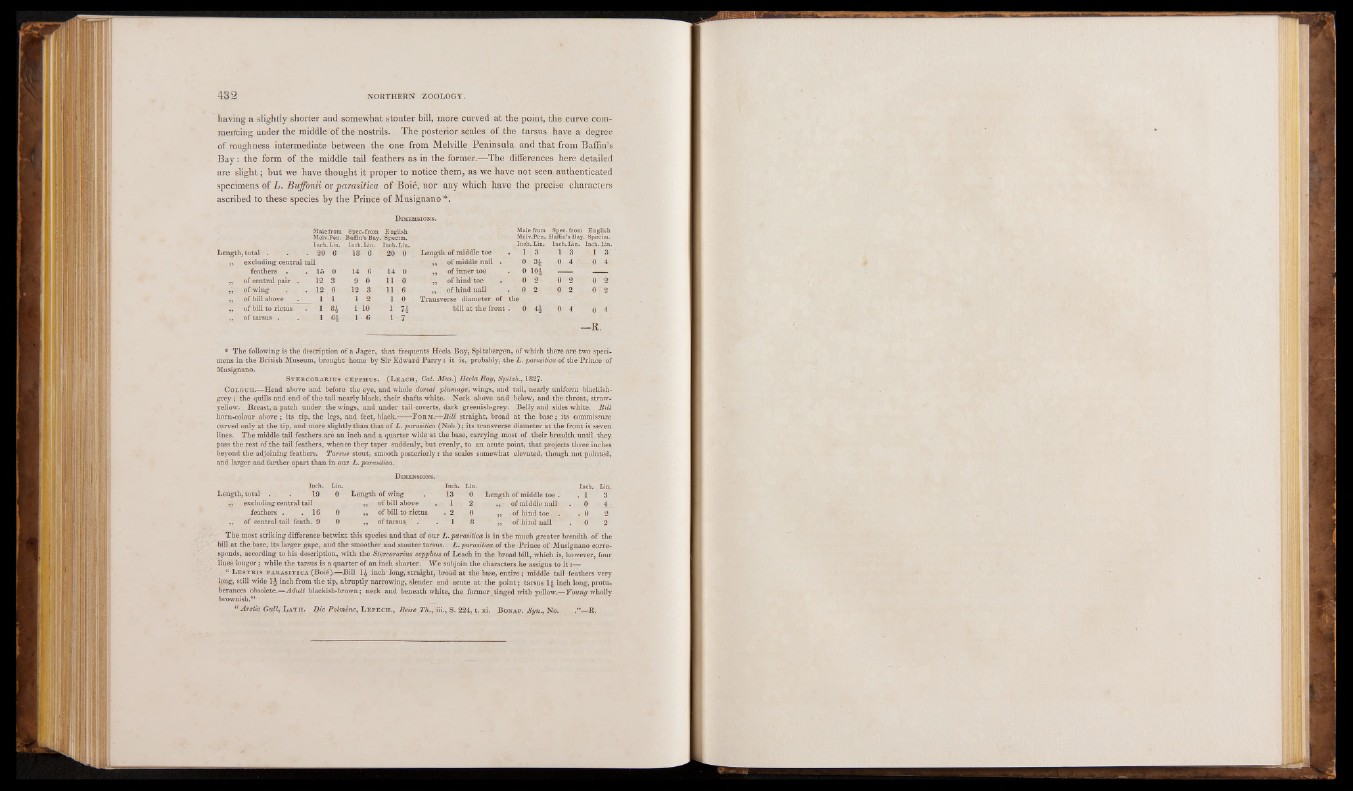
having a slightly shorter and somewhat stouter bill, more curved at the point, the curve commencing
under the middle of the nostrils. The posterior scales of the tarsus have a degree
of roughness intermediate between the one from Melville Peninsula and that from Baffin’s
Bay: the form of the middle tail feathers as in the former.—The differences here detailed
are slight; but we have thought it proper to notice them, as we have not seen authenticated
specimens of L. Buffonii or parasitica of Boie, nor any which have the precise characters
ascribed to these species by the Prince of Musignano *.
Dimemsions.
MMeallve .fProenm. BSapffeicn,’ sf rBoamy . SEpnegcliimsh. MMaellev .fProemn. BSapffeicn,’ sf rBoamy . SEpnegcliimsh.
Inch. Lin. Inch. Lin. Inch. Lin. Inch. Lin. Inch.Lin. Inch. Lin.
Length, total . . 20 6 18 6 20 o ; Length of middle toe . 1 3 1 3 1 3
„ excluding central tail „ of middle nail . 0 3£ 0 4 0 4
feathers . . 1 5 0 14 6 14 0 ,,. of inner toe . o 104 — —
,, of central pair . 12 3 9 0 11 0 ' „ • of hind toe . 0 2 0 2 0 2
' of wing . 12 0 12 3 11 6 „ of hind nail . 0 2 0 2 0 2
„ of bill above 1 '1 1 2 1 Q__. Transverse diameter of the
„ of bill to rictus . 1 8| 1 10 1 7i bill at the front • 0 44 0 4 0 4 ,, of tarsus . 1 6 | 1 —6 1 7 —R.
* The following is the description of a Jager, that frequents Hecla Bay, Spitzbergen, of which there are two specimens
in the British Museum, brought home by Sir Edward Parry: it is, probably, the L. parasitica of the Prince of
Musignano.
STERCOR.AR.itrs c e p p h u s . (L ea c h , Cat. Mas.) Hecla Bay, Spilzb., 1827.
C o lo u r .—Head above and before the eye, and whole dorsal plumage, wings, and tail, nearly uniform blackish-
grey ; the quills and end of the tail nearly black, their shafts white. Neck above and below, and the throat, straw-
yellow. Breast, a patch under the wings, and under tail coverts, dark greenish-grey. Belly and sides white. Bill
horn-colour above; its tip, the legs, and feet, black.-----F o rm.—Bill straight, broad at the base; its commissure
curved only at the tip, and more slightly than that of L. parasitica (Nob.); its transverse diameter at the front is seven
lines. The middle tail feathers are an inch and a quarter wide at the base, carrying most of their breadth until they
pass the rest of the tail feathers, whence they taper suddenly, but evenly, to an acute point, that projects three inches
beyond the adjoining feathers. Tarsus stout, smooth posteriorly: the scales somewhat elevated, though not pointed,
and larger and farther apart than in our L. parasitica.
Dimensions.
Length, total . . 19
Lin.
0 Length of wing
Inch. Lin.
13 0 Length of middle toe . . 1
Lin
„ excluding central tail „ of bill above 3 1 ; 2 „ of middle nail 0 4
feathers . . 1 6 0 „ of bill to rictus . 2 0 „ - of hind- toe... . 0 2 . ,, of central tail feath. 9 0 „ ' of tarsu$ . 1 8 " „ of hind nail 0 2
The most striking difference betwixt this species and that of our L. parasitica is in the much greater breadth of the
hill at the base, its larger gape, and the smoother and stouter tarsus. L. parasitica of the Prince of Musignano corresponds,
according to his description, with the Stercorarius cepphus of Leach in the broad bill,, which is, however, four
lines longer ; while the tarsus is a quarter of an inch shorter. We subjoin the characters he assigns to it :—
. “ L e s t r is pa r a s it ic a (Boié).—Bill 1£ inch long, straight, broad at the base, entire; middle tail feathers very
long, still wide 1£ inch from the tip, abruptly narrowing, slender and acute at the point ; tarsus If inch long, protubbérorawnnciessh
.o’’bsolete.—Adult blackish-brown; neck and beneath white, the former .tinged with yellow.—Young wholly
“ Arctic Gully Lath. Die Polmène, Lepech., Reise Th., iii., S. 224, t. xi. Bonap. Syn.. No. .”—R.